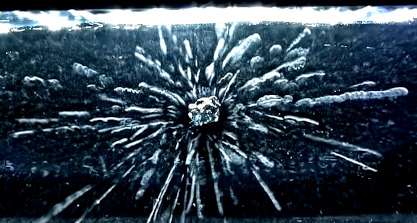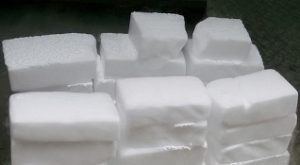How to Make a Cloud Chamber

Uranium emitting alpha particles
in a cloud chamber at CloudyLabs
Choosing One
When deciding how to build a cloud chamber, it’s best to consider a few factors before choosing a set of plans. We selected our favorite resource for each of several, simple versions or models, below (and threw in where to get rare, hard-to-find source material as well)!
Keeping it Simple
Most visitors want to take a simple route rather than making formidable project out of it, as is required for professional models with electrically-powered coolers and heaters. We’ll link those, as well, but the easiest types use simple materials that are readily available. Versions range anywhere from a mere petri dish on a slab of dry ice, to professional thermoelectric units generating their own warm or cold regions, or even models that control the paths of detected particles. We’ll feature a separate article on the latter, most sophisticated types.
Easiest Builds Use Dry Ice

Note: When we refer to “dry ice” we mean genuine, frozen CO2, not those reusable cooler packs or plastic containers full of frozen media often called “dry ice” by some companies. Real dry ice is surprisingly available in the US. Supermarkets such as Publix and Walmart have begin carrying dry ice under brands such as Penguin, just ask management or customer service..
Warning: Frozen, solid CO2 dry ice is cold enough to cause damage to your bodily tissues with more than a quick poke, so you cannot safely handle it without thick insulation or tongs etc.. Also, a lot of dry ice in a confined area can cause unsafe levels of CO2, but that concern has more to do with large quantities or people trying to immerse themselves in its fog.
Winner of the the elegantly simple award:
The Dept. of Energy’s Jefferson Lab shows how to build cloud chamber from a petri dish, felt, and 91% rubbing alcohol (not 70%).
A step up:
#1 in Popularity (with dry ice)
Below is how to construct the quintessential favorite cloud chamber with the fumes raining down from a sponge on the ceiling of a more substantial, aquarium-like container. Still, we’re talking about few items even from a dollar store fitting the bill, but for a spectacular show. It doesn’t have to be this large (such as in the Without Dry Ice version further down – that one has a very common, smaller dollar store clear breakfast cereal “tank”).
The US LHC (of CERN) provides a concise tutorial for making this all-time favorite version:
What’s great is they also offer the accompanying S’Cool Lab manual in PDF free for download:
PDF Instruction Set Download Link
Symmetry Magazine‘s Step by Step version of the same type:
How to Build a Cloud Chamber (with dry ice)
How to Make a Cloud Chamber Without Dry Ice
You may pursue building a cloud chamber without dry ice, using gel packs or polymers, particularly if you have no easy access to dry ice.
The construction requirements are slightly more involved, however, when substituting polymer in place of dry ice. So, if you do have access to dry ice, you may decide the dry ice model is the easiest route for you (and a little more foolproof, it seems, with a couple fewer variable).
The project is similar for both the simple DIY models of could chamber, whether they use dry ice or freezer gel packs but, because the gel packs are not as cold, the no-dry-ice-required model includes a couple of extra, special needs. It requires a minimum vertical height and it requires added heat on top, like a reservoir of hot water which is not really required for dry ice models for an adequate temperature gradient above to cold floor.
Note – The following is not mentioned in the video but is important:
You can see the bottom reservoir (functioning as the cloud chamber) is taller than the one on top. Harold Henderson’s experiments showed that this extra, vertical space was necessary (versus using two the same size as the shorter, top container) i.e. a good 15 or 20cm cloud chamber height is needed for the no-dry-ice version.
Professor Paul Looyen of Physics High hosts the world’s most popular video how to build a cloud chamber without dry ice:
If you’d like to get into various methods of electrically powering methods of heating or cooling, experimenting with supposedly making the trails more visible with a high voltage differential field, or hijacking particles and directing them with electromagnetic fields, we’ll soon feature a new article on those. For now, get your feet wet and keep it simple.
Finding radioactive source material:
It’s the most fun seeing or measuring radioactivity when you can compare a collection of check sources ranging from lower to higher (staying safe, of course, with proper information, handling, and storage).
Uranium glass and 2% thorium, tungsten welding rods, and maybe a vintage gas lantern mantle are available everywhere, but the rarer check sources on the higher end of safe and legal (like uranium mica crystals, or desert rocks with unusually high ore inclusions) can be expensive or hard to find. When you want the piece de resistance or grand finale to look like fireworks in the cloud chamber, we suggest:

(must be 18 or older to purchase ore)
How to Make a Cloud Chamber Read More »
